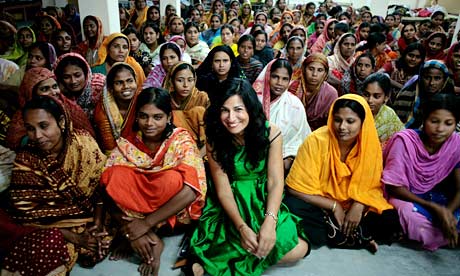
Congratulations New York University students in Paris! You have completed Fashion & Power.








Fashion documentaries have taken a popular upturn in the 21st century as more and more people grow increasingly curious about the elusive and exclusive world of fashion. By allowing outsiders a peek into this elite society, fashion documentaries are able to give insightful views of what goes on behind the scenes of the 300 billion dollar industry.
Two of the most well-known fashion documentaries The September Issue and Valentino: The Last Emperorserve as examinations of the fashion industry and the people that run it, whether it is Wintour directing fashion media or Valentino supervising fashion production.
 Vogue September 2007 Issue, Cover with Siena Miller
Vogue September 2007 Issue, Cover with Siena MillerIt is without a doubt that Anna Wintour is one of the most important and publicly recognized figures in the realm of fashion. As the Editor-in-chief of American Vogue (also dubbed the fashion bible), the Britain-born Wintour is constantly in the limelight. She is constantly described to be aloof and unapproachable by the media, earning herself nicknames such as “Nuclear Wintour” [1]. and “Ice Queen”[2] Produced in 2009 and directed by R.J Cutler, The September Issue is a documentary that closely monitors the making of the Vogue September 2007 issue, an edition that was publicized as the magazine’s largest issue to date. As the star of the film, Wintour brought much interest to the movie with her detached and cold guise. And yet, the huge amount of hype behind The September Issue was not only due to the public’s curiosity and Wintour’s reserved nature towards the media. One should also credit the success of the movie, The Devil Wears Prada, a loose adaptation from Lauren Weisberger’s best-selling novel of the same name, which elevated Wintour’s celebrity status back in 2006 for the similarities she shared with the titular character Miranda Priestly, a tyrannical, demanding boss who oppressed her subordinates.

The September Issue Trailer:http://www.youtube.com/watch?v=Tq4wo4JYy2s
This contrasting dynamic of a creative mind paired together with the brains behind the business is seen as well in Valentino: The Last Emperor. Despite its numerous lighthearted and comedic moments, the film ultimately trails Valentino’s final glory days as a fashion designer, leading up to a climatic moment whereby the possibility of Valentino’s retirement is put into question. Known to be the last true couturier, the film gives an insightful view into the glamorous, excessive lifestyle of Valentino Garavani. Produced in 2008, Matt Tyrnauer directs the documentary, revealing the legacy of Valentino to the audience, in which they see the history behind the founding of his company and the contrast it has with his present-day life. The Italian fashion designer and founder of the Valentino SpA brand and company is renowned to have dressed some of the world’s most glamorous women such as Audrey Hepburn, Elizabeth Taylor and most notably, Jackie O[3].
 Valentino at his 45th Anniversary Celebration in Rome
Valentino at his 45th Anniversary Celebration in RomeValentino: The Last Emperor Trailer: http://www.youtube.com/watch?v=UGJJRPWqvzM
Concluding, with the many different minds working within the fashion industries, it is unavoidable that there will be collisions and conflict of ideologies and personalities. As portrayed by the documentaries, the working relationships between Wintour and Coddington as well as Valentino and Giancarlo are ones filled with tension and disagreements due to incompatible principles and ideas, but what holds each partnership together is the equal effort and desire to reach a shared goal. Thus, both films portray a dynamic working relationship that has resulted in the garnering of strong influence in the industry through the collaboration between the creative and the commercial.
[1] “The September Issue”. Credit (R.J Cutler). Actual Reality Pictures. 2009. In a scene where Wintour cuts several of the photographs from a photoshoot titled' Paris Je T’aime' (photographed by Steven Meisel), Coddington bemoans to her colleagues, "She's killed half of it."
[2] Moylan, Bryan. “How Grace Coddington Stole The September Issue from Anna Wintour” Herogram. http://gawker.com/#!5344335/how-grace-coddington-stole-the-september-issue-from-anna-wintour
[3] “Valentino: The Last Emperor”. Credit (Matt Tyrnauer). Acolyte Films. 2008.
[1] Oppenheimer, Jerry. “Front Row: Anna Wintour” Saint Martin's Press Inc. (25 Feb 2005) pp. 243.
[2] “The September Issue”. Credit (R.J Cutler). Actual Reality Pictures. 2009.
















